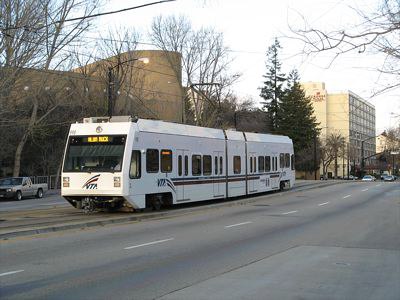No Light Rail in Vancouver!

When there is just one car, it is not a train. Flickr photo by LazyTom.
Here are just a few examples of VTA’s poor performance. (All of these numbers are based on the National Transit Database and can be found in my summary of that database.)
- In 2005, the average VTA light-
rail car had just 13.1 riders on it at any given time (passenger miles divided by vehicle revenue miles), compared with a national average of 25.2. The only light- rail system that was worse was Denver’s, but Denver runs three- car light- rail trains while San Jose runs one- or two- car trains, which means San Jose has fewer riders per train. - Another measure of San Jose’s poor light-
rail patronage is through- put: passenger miles per mile of track. The nation’s average light- rail line moves 4.8 million passenger miles per mile of track each year. San Jose’s moves just 1.5 million, less than any other light- rail system in the country. - Hay measures performance in terms of transit trips per vehicle revenue hour. VTA’s
light-
rail system carried 44 trips per revenue hour, the lowest of any light- rail system and about half the average for light rail. - VTA’s bus system carried 25 trips per vehicle revenue hour, well below the national average of 35.
- Fares in recent years have covered just 13 to 14 percent of operating costs (and, of course, none of its capital costs). This is well below the industry average of 35 percent, not to mention VTA’s own target of 20 percent.
VTA’s poor performance is immediately traceable to the high cost of light rail. Rail
construction put VTA deeply into debt. Declining tax revenues after the dot-
No other major transit system saw such a big decline in ridership during this time period. APTA figures indicate that rail ridership recovered somewhat in 2006, but bus ridership did not, so total 2006 ridership was still nearly 30 percent below 2001 levels.
VTA’s fundamental problem is that light rail is totally unsuited for an urban area
like San Jose. I don’t think light rail makes sense anywhere, but if it did make
sense, it would be in an area with a concentrated downtown job center surrounded
by suburbs that included at least some higher-
My previous post on transit capacities points out that an exclusive bus lane has
a far greater capacity to move people than light rail. But buses also make sense
in low-
As if light rail weren’t enough of a waste of money, VTA is intent on bringing BART
(heavy rail) to San Jose. BART would cost far more to build per mile than light rail,
yet the awkward routing through Fremont does not justify heavy-
In 2004, the Federal Transit Administration gave the San Jose BART line a “not recommended” rating due to “the poor operating financial condition of SCVTA.” Both the Sierra Club and the BayRail Alliance oppose the San Jose BART extension because it would draw too many resources from other, more productive transit projects.
As the Hay Group report reverberates around Silicon Valley, maybe it will force local
leaders to rethink the BART plans. If so, then maybe VTA can also be persuaded to
give up any further expansions of its pathetic light-
1
Trackback • Posted in Planning Disasters, Transportation, Urban areas
The Nation’s Worst Transit Agency

I’ve previously noted that the Santa Clara Valley Transportation Authority (VTA)
may be the nation’s worst-
The new report was written by a company called Hay Group. Most consultants fawn all over their clients, but this report is surprisingly frank. Among other things, it accuses VTA of building “capital projects” (i.e., light rail) that benefitted politically powerful neighborhoods without insuring that it had the money to operate those projects. The result is low ridership and high operating costs.
Reprinted from The Antiplanner